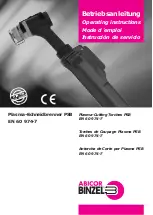
Version November 2021
12
EN
HWT 160 SW – S User’s Manual
H Ü R N E R S c h w e i s s t e c h n i k G m b H
Nieder-Ohmener Str. 26
35325 Mücke, Germany
ing towards the pipe. Make sure that the far end of the
branch‑off is flush with and firmly pressed against the
raised bead at the edge of the clamps. Turn the hand‑
wheel for the clamps of the clamping console to the
point where the fitting is secured fast between them.
Important
The concave edge of the nipple of the branch‑off
fitting has to fit the rounded shape of the pipe per‑
fectly to ensure that the joint will be reliable. Use ex‑
treme care when aligning the branch‑off to the pipe
and, if needed, close the clamping console in on the
pipe several times to allow for more precise align‑
ing. Octagonal clamps for the clamping console are
available and will facilitate the proper alignment of
saddle branch‑offs with an octagonal body.
7. Close the branch‑off sitting in its clamp in on the open‑
ing in the pipe in order to align them on each other
and check one final time and, if needed, to adjust their
proper alignment. If the relative position of both is in
order, i. e., the components are ready for welding, ad‑
just both setpoints positions. The one on the side where
the welder stands determines how far the nipple of the
branch‑off fitting will be inserted into the opening in
the straight pipeline dur‑
ing fusion/jointing. The
one on the far side from
the welder determines
the distance to to detach‑
ing, i. e., what is the maxi‑
mum distance how far the
clamping console can/must
be retracted from the pipe
towards the welder, using
the handwheel for moving
the clamping console, in
order to detach the plasticized material from the heat‑
ing socket and spigot on the heating element after the
bead build‑up and heating.
8. Using the carriage‑moving handwheel, move the clamp‑
ing console back to the start‑up position (basic chassis
“open” to the maximum).
5.3
Welding Process
Caution
The handwheel moving the clamping console of the
basic chassis can be removed and, optionally, re‑
placed with a drive power tool (e. g., common cord‑
less drill/screwdriver) fitted to the basic chassis with
a dedicated adapter. This allows using the power
tool for
all
movements of the clamping console dur‑
ing preparation and welding. When using a power
tool and the adapter, be sure to set the tool to its
lowest speed and lowest operating force. If the tool
Setpoint für Distance
to Detaching
Setpoint for
Fusion Depth
















































